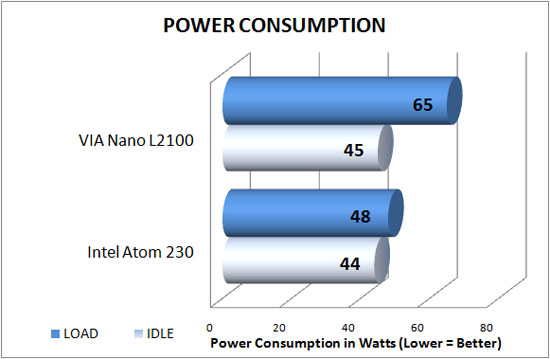Intel ATOM 230 versus VIA Nano L2100 – Battle of the Mini-ITX Platforms
Power Consumption and Final Thoughs
Since power consumption is a big deal these days, we ran some simple power consumption tests on our test beds. The systems ran with the power supplies, case fan, video card and hard drive model. To measure idle usage, we ran the system at idle for one hour on the desktop with no screen saver and took the measurement. For load measurements Cinebench R9.5 was run on all cores to make sure each and every processor was at 100% load. All of the systems used identical hardware minus the motherboard and processor.

Power Consumption Results: For testing power consumption I took our test system and plugged it into a Seasonic Power Angel and the results showed both systems consumed roughly the same about of power at idle. The VIA Nano L2100 processor consumes way more power than the Intel Atom 230 under full CPU load as seen in the chart above. Remember the Nano L2100 has a TDP of 25W and the Atom 230 has a TDP of 4W, so these results are about what I expected.
Final Thoughts and Conclusions
I’m sure a fair number of you expected the VIA Nano L2100 to come out ahead because it operates at 1.8GHz, while the Intel Atom 230 runs at just 1.6Ghz, but there is more to it than the 12.5% difference in clock frequency. The VIA Nano processor is based on superior superscalar out of order architecture, which is why it performs better than the Intel Atom processor. The VIA Nano processor beat the Intel Atom processor in every single performance benchmark we ran and that says a ton for the engineers (Centaur Technologies) who designed the Nano processor. The only area the VIA Nano didn’t excel at was power consumption testing, which Intel clearly has a lead thanks in part to their advanced 45nm technology process.
The overall performance of both platforms is lower than what many of you might expect from a desktop computer, but keep in mind these are super low-cost PC’s here! I spent well over a week with each system running Windows Vista 32-bit and noticed that they did well for internet surfing and general Microsoft Office usage, but for the most part were slow compared to the systems I usually run for gaming or office work. When using each system on the desktop the VIA Nano platform had a quicker feel to it even though the Intel Atom had Hyperthreading enabled.
In the end all that matters is what you can buy today and when it comes to that Intel has far more availability with the Atom platform. If you wanted to buy an Intel Atom Mini-ITX motherboard you could follow this link right here and for $66 plus shipping you can have an Atom platform as fast as they can ship it. The VIA Nano Mini-ITX platform is still a reference design and you can’t purchase anything right now. VIA plans on having the Nano processor in a variety of systems, so over time you’ll see them pop up in devices like the HP Mini-Note 2133. The HP Mini-Note 2133 is one of those uber sexy and sleek Netbooks that people envy in case you didn’t know. Basically what we have here is a superior processor, but a lack of platforms and chipsets to take advantage of it. Once VIA gets some systems using this processor they will be sitting pretty till the next Nano and Atom battle, which from what we have been hearing will be these processors in a dual-core configuration.
Legit Bottom Line: The VIA Nano L2100 straight up owns the Intel Atom 230 when it comes to the benchmarks, but good luck trying to find a platform today if you want to purchase something right now.

Comments are closed.